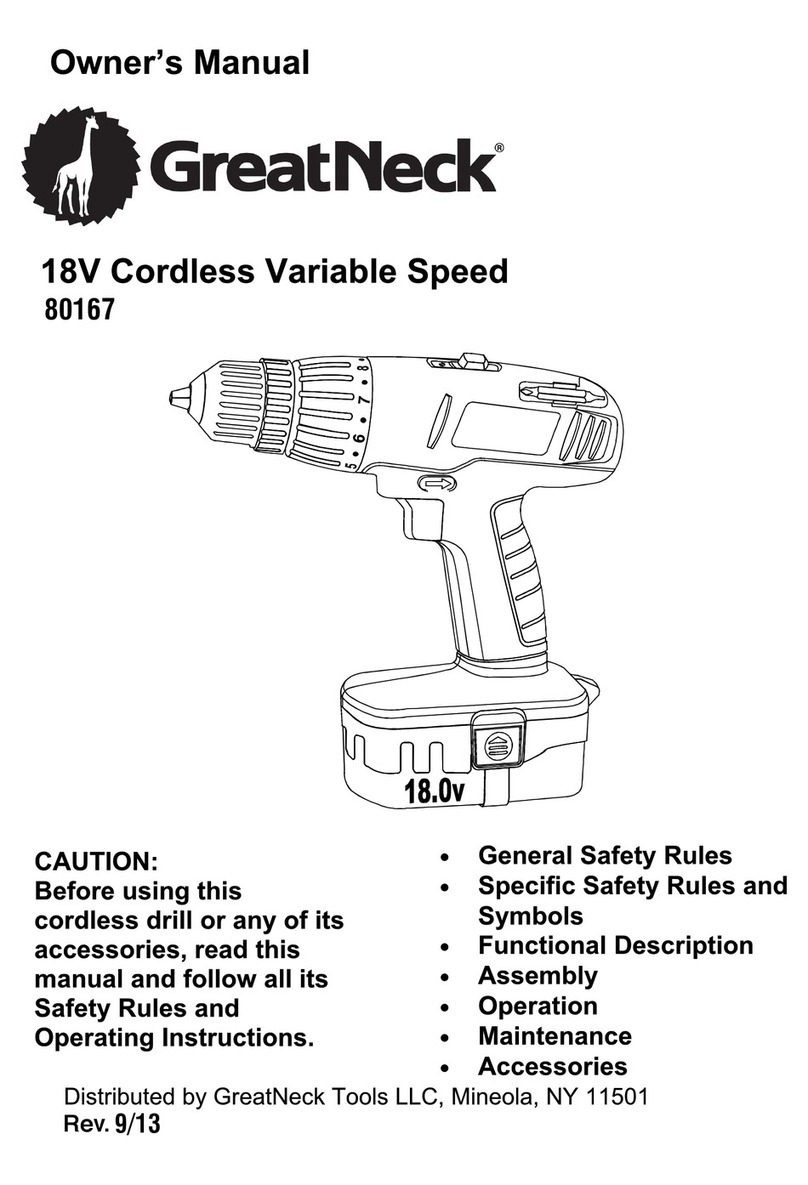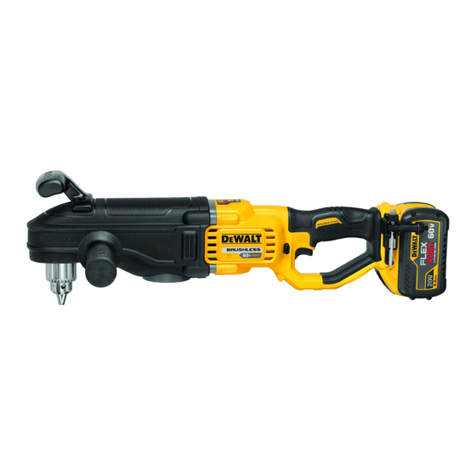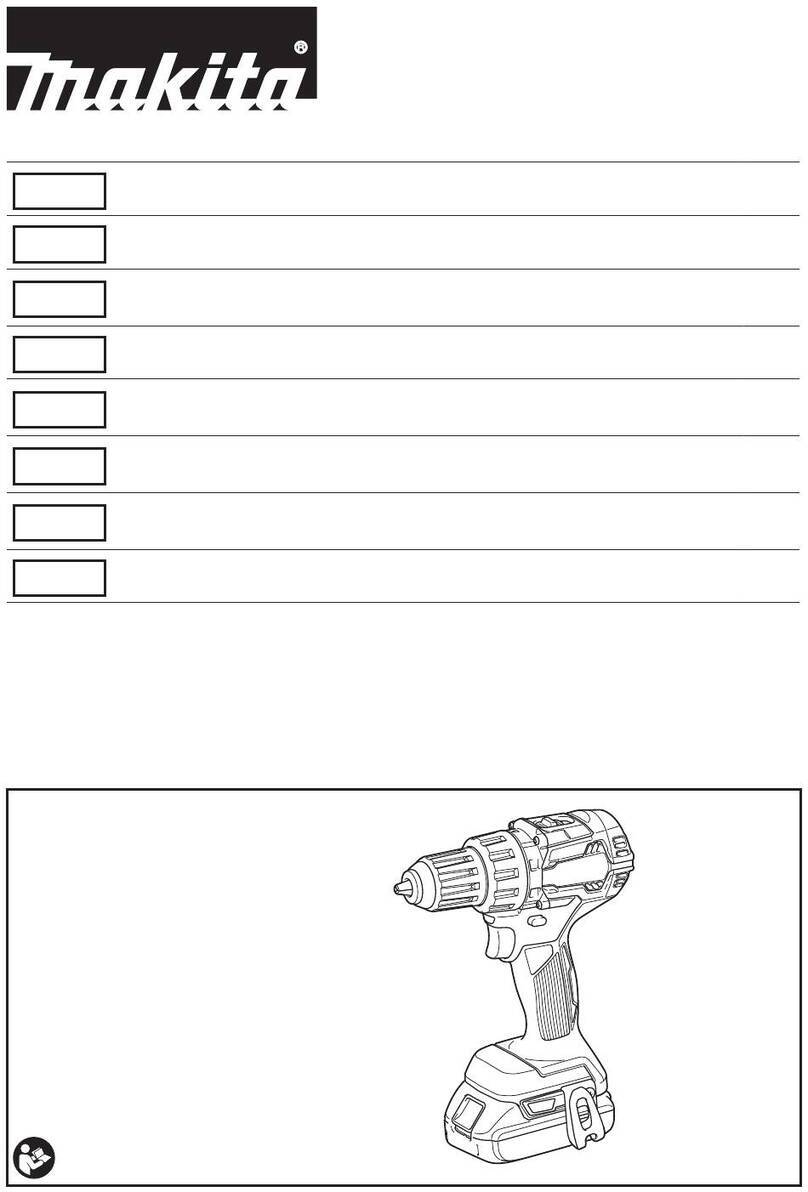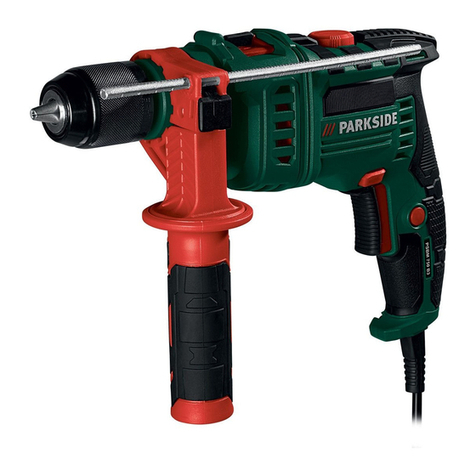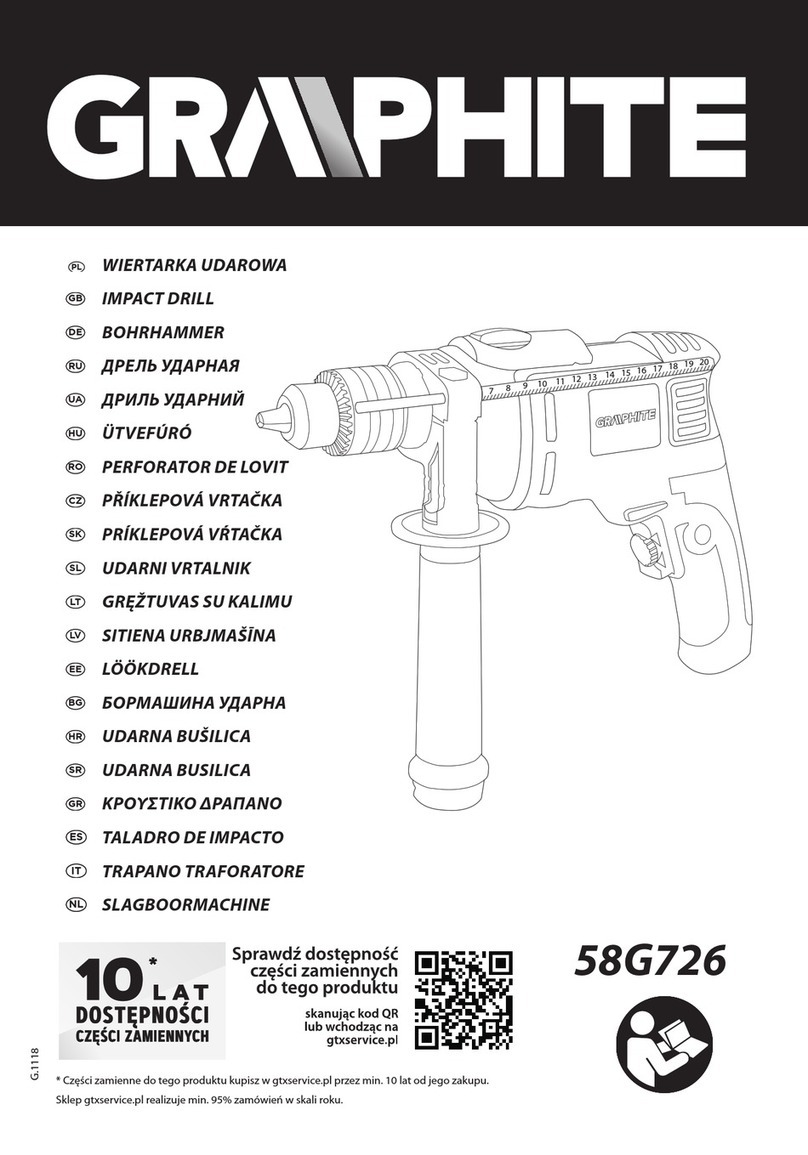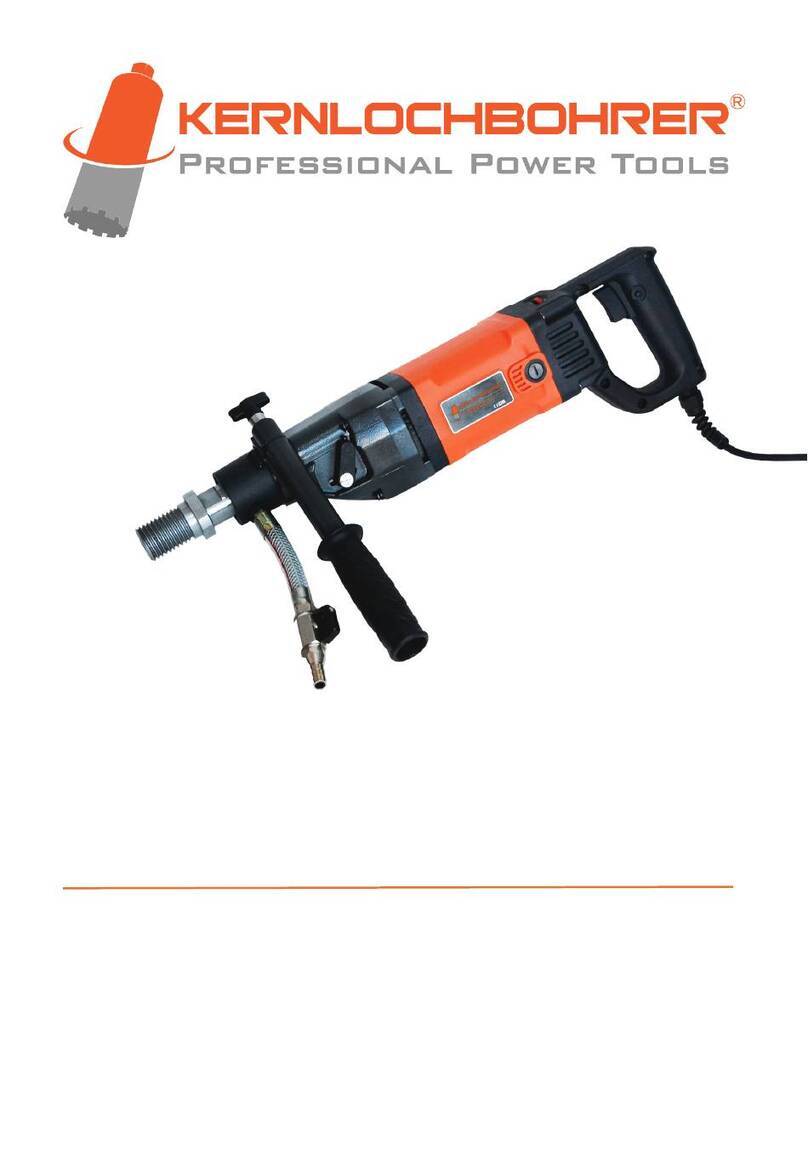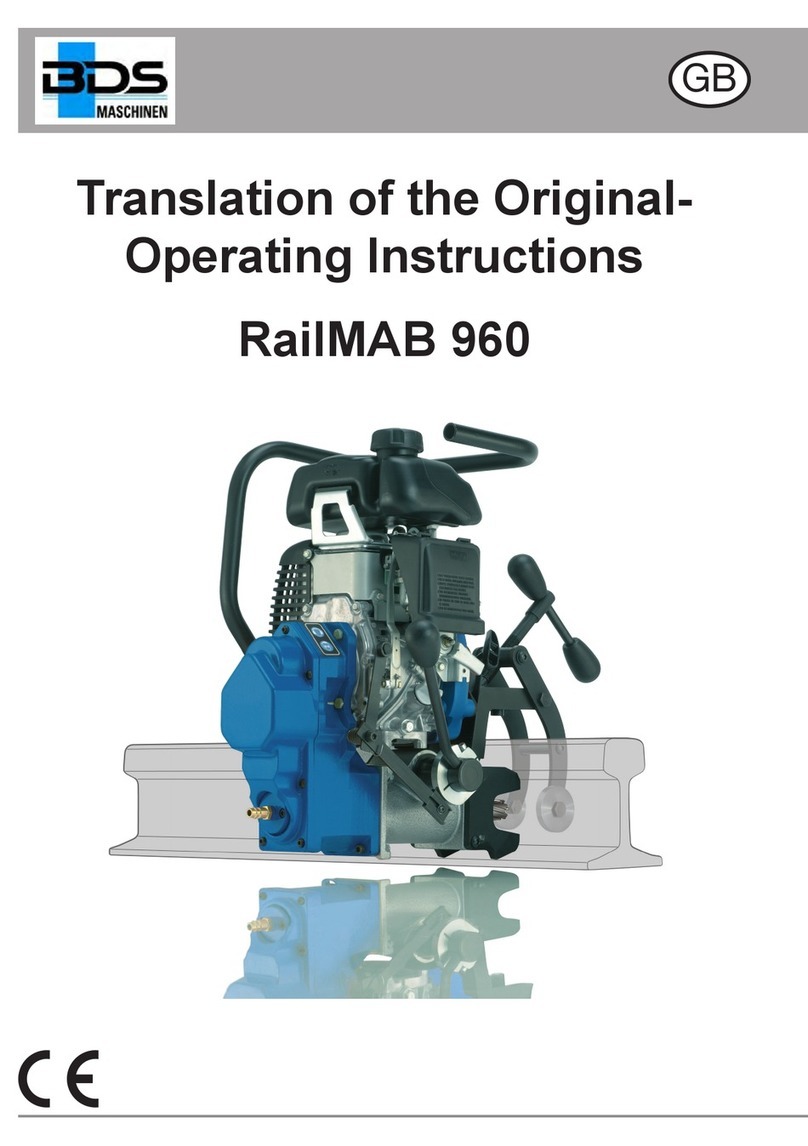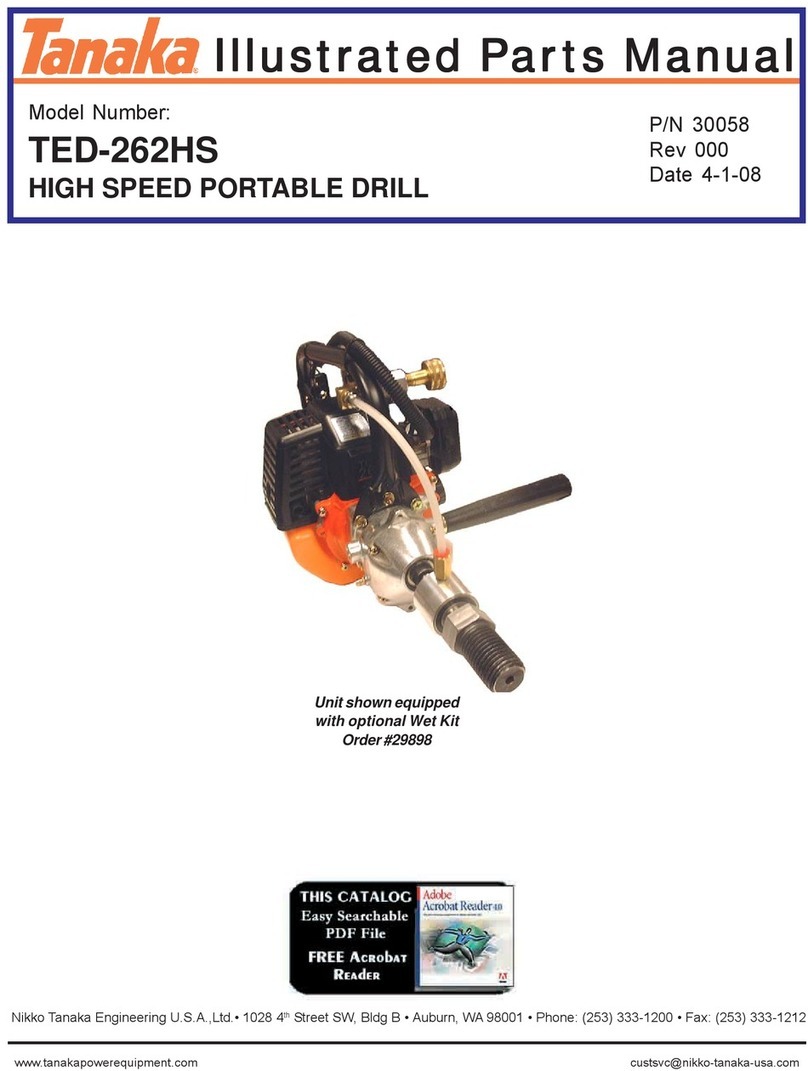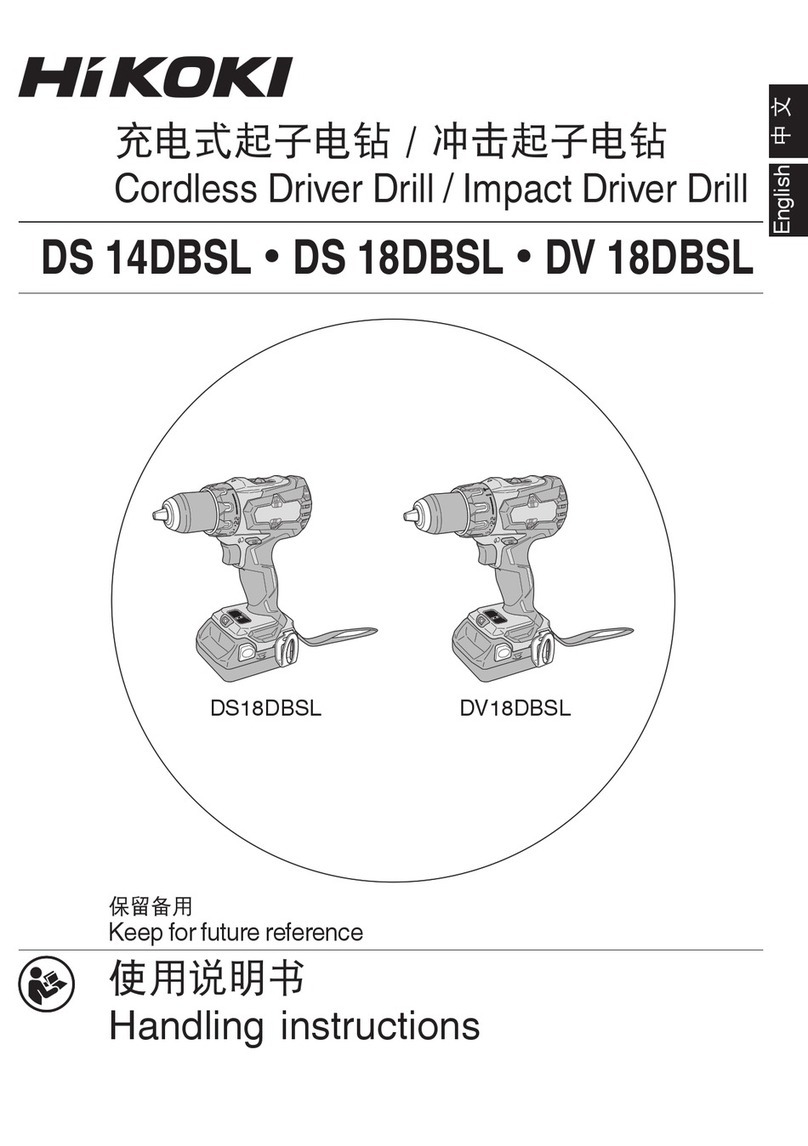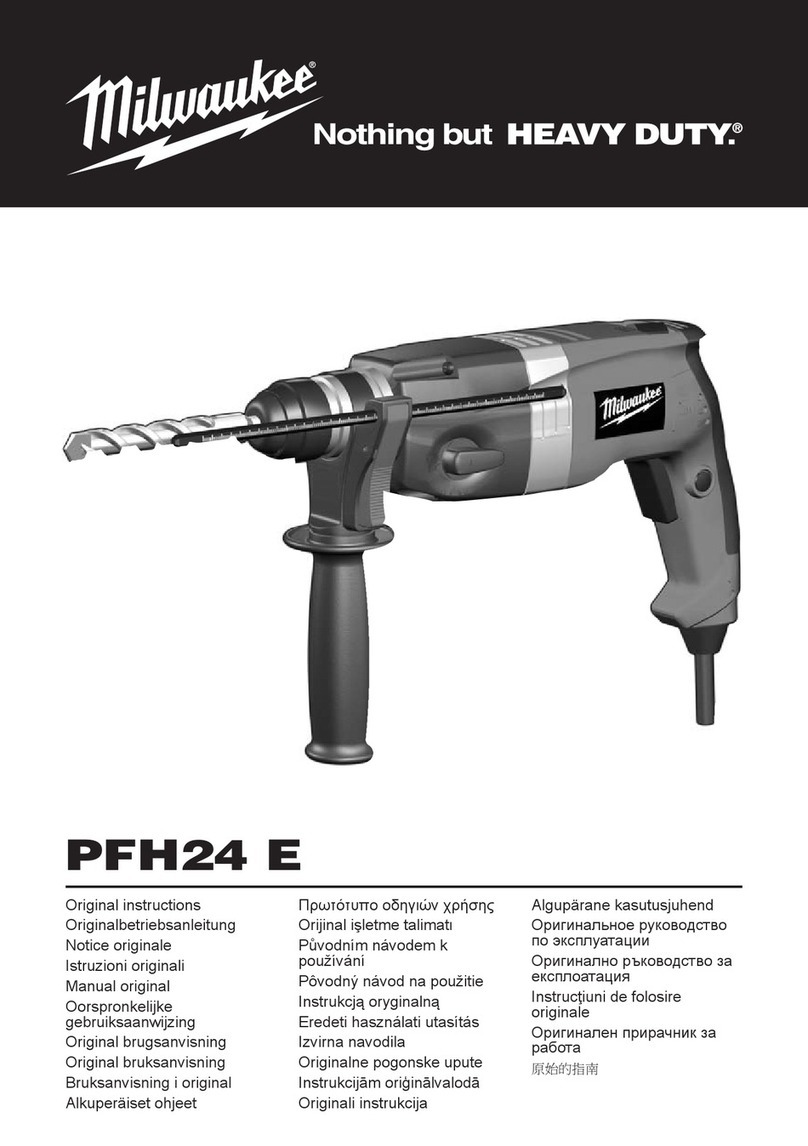Greatneck 80154 User manual

Owner’s Manual
3/8" Drill
80154
CAUTION:
Before using this drill
or any of its
accessories, read this
manual and follow all
Safety Rules and
Operating Instructions.
•
General Safety Rules
•Specific Safety Rules
and Symbols
•Functional Description
•Assembly
•Operation
•Maintenance
•
Accessories
GreatNeck Tools, LLC Mineola, NY 11501
Rev 7/10

2
SECTION
PAGE
SECTION
PAGE
Warranty ….……………………….
2
Know your drill …………………
8
Product specifications …………...
2
Accessories ……………………
9
Power tool safety ………………… 3–5 Carton contents……..……….... 9
Specific safety rules ……………..
5
Assembly & operation ..………
10
–
13
Extension cord guidelines ..……..
6
Maintenance …….……………..
14
Symbols …………………………..
7
Parts & service ..……..………..
15–
16
WARRANTY
TABLE OF CONTENTS
GREATNECK®ONE YEAR LIMITED WARRANTY
If within one year from date of purchase, this product fails due to a defect in
materials or workmanship, return the product with proof of purchase, postage
prepaid to Great Neck Saw Mfrs.Inc., Mineola, NY 11501, for replacement with
an item of equal or greater value. This warranty excludes
incidental/consequential damages and failures due to misuse, abuse or
abnormal wear and tear.
This warranty gives you specific rights, and you may also have other rights,
which vary from state to state.
This product is not guaranteed if used for industrial
or commerical purposes.
Customer Service 1-866-458-2472
SPECIFICATIONS
Rating ……………………… 120 V, 60 Hz, AC
Amperes …………………… 3.5 A
Motor speed ………………. 2500 RPM (no load)
Reversible ………………... Yes
Chuck ……………………… 3/8” keyless
Max. drilling capacity in metal 3/8” (10 mm)
Weight ……………………... 3 lb 7 oz (1.57 kg)

3
POWER TOOL SAFETY
WARNING: To avoid electricalhazards, fire hazards ordamage to the drill, use
proper circuit protection.
Thedrill is wired at the factory for 120 V operation. It must be connected to a 120 V,
15 A time delayed fuse or circuitbreaker. To avoid shock or fire, replace power cord
immediately ifitis worn, cut ordamaged in any way.
!
SAVE THESE INSTRUCTIONS FOR REFERENCE
!
ALWAYS WEAR EYE PROTECTION THAT CONFORMS WITH CSA
REQUIREMENTS or ANSI SAFETY STANDARD Z87.1
FLYING DEBRIS can cause permanent eye damage. Prescription
eyeglasses ARE NOT a replacementfor proper eye protection.
WARNING: Non-compliant eyewear can cause serious injury ifbroken
during operation of a power tool.
GENERAL SAFETY RULES
WARNING: Read and understand
all instructions. Failure to follow all
instructions listed below may result in
electric shock, fire and/or serious personal
injury.
WORK AREA
Keep your work area clean and well lit.
Cluttered benches and dark areas invite
accidents.
Do notoperate power tools in explosive
atmospheres, such as in the presence of
flammableliquids, gas or dust. Power
tools create sparks which may ignite the
dust or fumes.
Keep bystanders, children and visitors
away while operating the tool.
Distractions can cause you to lose control.
!
ELECTRICAL SAFETY
Doubleinsulated tools are equipped
with apolarized plug (one blade is wider
than the other). This plug will fit in a
polarized plug only one way. If the plug
does not fit fully in the outlet, reverse
the plug.Ifit still does not fit, contact a
qualified electrician to install apolarized
outlet. Do not change the plug in any
way. Double insulation eliminates the need
for the three-
and grounded power supply system.
Avoid body contact with grounded
surfaces such as pipes, radiators,
ranges and refrigerators. There is
increased risk of electric shock if your body
is grounded.
Don’t expose power tools to rain or wet
conditions. Water entering the power tool
will increase the risk of electric shock.
prong grounded power cord

4
Do not abuse the cord. Never use the
cord to carry the tools or pull the plug from
an outlet. Keep cord away from heat, oil,
sharp edges or moving parts. Replace
damaged cords immediately. Damaged
cords increase the risk of electric shock.
When operating a power tool outside,
use an outdoor extension cord marked
“W-A” or “W”. These cords are rated for
outdoor use and reduce the risk of electric
shock.
PERSONAL SAFETY
Stay alert, watch what you are doing and
use common sense when operating a
power tool. Do not use the tool while
tired orunder the influence of drugs,
alcoholor medication.A moment of
inattention while operating power tools may
result in serious personal injury.
Dress properly. Do not wear loose
clothing or jewelry.
Contain long hair. Keep your hair,
clothing and gloves away from moving
parts. Loose clothing, jewelry or long hair
can be caught in moving parts.
Avoid accidental starting. Be sure
switch is OFF before plugging in.
Carrying tools with yourfinger on the switch
or plugging in tools that have the switch
turned ON invites accidents.
Remove adjusting keys or wrenches
before turning the tool ON. A wrench or
key that is left attached to a rotating part of
the tool may result in personal injury.
POWER TOOL SAFETY
SAVE THESE INSTRUCTIONS FOR REFERENCE
Do notoverreach. Keep proper footing
and balance at all times.Properfooting
and balance enables better control of the
tool in unexpected situations.
Use safety equipment. Always wear eye
protection.Dust mask, non-skid safety
shoes, hard hat or hearing protection must
be used under applicable conditions.
TOOL USE AND CARE
Use clamps or other practical method to
secure and support the workpiece on a
stable platform. Holding the work by hand
or against your body is unsafe and may
lead to loss of control.
Do not force the tool. Use the correct
tool for your application. The correct tool
will do the job better and safer at the rate
for which it is designed.
Do notuse the tool if the switch does
not turn it ON or OFF.Any tool that cannot
be controlled with the switch is dangerous
and must be repaired.
Disconnect the plug from the power
source before making any adjustments,
changing accessories or storing the
tool.Such preventive safety measures
reduce the risk of starting the tool
accidentally.
Store idle tools out of reach of children
and other untrained persons. Tools are
dangerous in the hands of untrained users.
Maintain tools with care. Keep cutting
tools sharp and clean. Properly
maintained cutting tools with sharp cutting
edges are less likely to bind and are easier
to control.

5
Check for misalignment or binding of
moving parts, breakage of parts and any
other condition that may affect the tool’s
operation.Ifdamaged, have the tool
serviced before using.Many accidents
are caused by poorly maintained tools.
Use only accessories that are
recommended by the manufacturer for
your model. Accessories that may be
suitable for one tool may become
hazardous when used on anothertool.
SERVICE
Tool service must be performed only by
qualified personnel. Service or
maintenance performed by unqualified
personnel could result in risk of injury.
When servicing a tool, use only identical
replacement parts. Follow instructions
in the Maintenance section of this
manual. Use of unauthorized parts or
failure tofollow Maintenance instructions
may create a risk of electric shock or injury.
POWER TOOL SAFETY
SAVE THESE INSTRUCTIONS FOR REFERENCE
WARNING: For your safety, do not
plug in yourdrill until you have carefully
read and understood this Owner’s
Manual.
ALWAYS WEAR EYE PROTECTION
THAT CONFORMS WITH CSA
REQUIREMENTS or ANSI SAFETY
STANDARD Z87.1
FLYING DEBRIS can cause
permanent eye damage.
Prescription eyeglasses ARE
NOT a replacement for proper
eye protection.
Do notinstall or use any drill bit that
exceeds 7” (175 mm) in length or extends
more than 6” (150 mm) beyond the chuck
jaws. They can bend or break suddenly.
Before starting the operation, jog the
drill switch to make sure the drill bit does
not wobble or vibrate.
Do notuse fly cutters or multiple-part
hole cutters, as they can come apart or
become unbalanced in use.
Make sure the spindlehas come to a
complete stop before touching the chuck
or attempting to change the drill bit.
SPECIFIC SAFETY RULES
!
Do not weargloves, neckties or loose
clothing.
Do not drill material too small to be
securely held.
Always keep hands out of the path of
the drill bit. Avoid awkward hand positions
where a sudden slip could cause your hand
to move into the path of the drill bit.
Secure workpiece. Use clamps or a vice
to hold the workpiece. It is safer than using
your hand and it frees both hands to
operate the tool.
Make sure there are no nailsor foreign
objects in the part of the workpiece to be
drilled.
To avoid injury from accidental starting,
always remove the battery from the tool
before installing or removing a drill bit.

6
SAVE THESE INSTRUCTIONS FOR REFERENCE
Make sure your extension cord is the
proper size. When using an extension
cord, be sure to use one heavy enough to
carry the current the tool will draw. An
undersized cord will cause a drop in line
voltage resulting in loss of power and
overheating. The table at right shows the
correct size to use according to cord length
and nameplate ampere rating. If in doubt,
use the next heavier gauge. The smaller
the gauge number the heavier the cord.
Be sure your extension cord isproperly
wired and ingood condition.Always
replace a damaged extension cord or have
it repaired by a qualified electrician before
using it. Protect your extension cord from
sharp objects, excessive heat and damp or
wet areas.
Use a separate electrical circuit for your
power tools. This circuit must not be less
than 14 gauge wire and should be
protected with either a 15Atime delay fuse
or circuit breaker. Before connecting the
power tool to the power source, make sure
the switch is in the OFF position and the
power source is the same as indicated on
the nameplate. Running at lower voltage
will damage the motor.
WARNING: Repair or replace
damaged or worn extension cords
immediately.
Select the appropriate extension cord
gaugeand length using the chart below.
!
EXTENSION CORD GUIDELINES
MINIMUM GAUGE (AWG) EXTENSION
CORDS (120 V use only)
Ampere rating Total length in feet
More
than
Not
more
than
25’50’100’150’
0
6
18
16
16
14
6
10
18
16
14
12
10
12
16
16
14
12
12 16 14 12 Not
Applicable

7
SAVE THESE INSTRUCTIONS FOR REFERENCE
V
volts
A
amperes
Hz
hertz
W
watt
kW
kilowatts
microfarads
L
litres
kg
kilograms
H
hours
N/cm
2
newtons per square
centimetre
Pa
pascals
Min
minutes
S
seconds
alternating current
three-phase alternating
current
three-phase alternating
current with neutral
direct current
no load speed
alternating or direct current
class II construction
splash proof construction
watertight construction
protective earthing at
earthing terminal, Class I
tools
revolutions or
reciprocations per minute
diameter
off position
arrow
warning symbol
WARNING: Some of the following symbols may beused on your
tool. Please study them and learn their meaning. Proper interpretation
of these symbols will allow you to operate the tool better and safer.
!
SYMBOLS
This symbol designates that
this tool is listed with both
Canadian and U.S.
requirements by Underwriters
Laboratories.
61TN
E213739
JD2009U

8
3/8” Keyless
chuck
Forward /
reverse lever
Lock-on
button
Trigger switch
KNOW YOUR DRILL

9
ACCESSORIES &
CARTON CONTENTS
DRILL COMPONENTS
DESCRIPTION
QTY
Drill
1
Owner’s manual
1
AVAILABLE ACCESSORIES
WARNING: Use only accessories
recommended for this drill. Follow
instructions that accompany
accessories. Use of improper
accessories may cause injury to the
operator or damage to the drill.
Do not use any accessory unless you have
completely read the instructions or Owner’s
Manualfor that accessory.
Drill bits
Screwdriver bits
WARNING: If any part is missing
or damaged, do not plug the drill into
the power source until the missing or
damaged part is replaced.
Carefully unpack the drill. Compare
contents against the “Drill Components”
chart below.
WARNING: To avoid fire or toxic
reaction,never use gasoline, naphtha,
acetone, lacquer thinner or similar
highly volatile solvents to clean the tool.
FORWARD/REVERSE LEVER
The forward/reverse lever (1) is
conveniently mounted above the trigger
lever (2) (see Fig. 1). To make the drill
rotate clockwise (for drilling) push the
forward/reverse lever tothe left. To make
the drill rotate counter-clockwise for
removing screws, push the forward/reverse
lever to the right.
NOTE: Never change position of the
forward/reverse lever while chuck is
turning.
TRIGGER SWITCH
This drill is equipped with a ON/OFF trigger
switch.
1. To start drill, gently squeeze the trigger
switch (1) (see Fig. 2).
2. To stop the drill, release the trigger
switch.
NOTE: Drilling for an extended period of
time may cause the drill motor to overheat.
If the drill motor gets hot, stop drilling and
allow to cool for at least 15 minutes.
CARTON CONTENTS
!
!
!
ASSEMBLY & OPERATION
Fig. 1

10
ASSEMBLY & OPERATION
TRIGGER SWITCH – cont’d
TRIGGER SWITCH LOCK
The trigger switch lock-on feature allows
the trigger switch to be locked in the ON
position when continuous operation for
extended periods of time is required (see
Fig. 3).
To lock the trigger switch in the ON
position, pull back on the trigger switch (1)
to start the drill and push the trigger switch
lock button (2) into the drill handle. Release
the trigger switch while holding the trigger
switch lock button into the drill handle. The
drill will continue to run. To release the
trigger switch lock button, pull trigger switch
back and then release the trigger.
INSTALLING DRILL BITS
WARNING: Never hold the chuck
body with one hand and use the drill
power to rotate the drillbody to loosen
or tighten bits. Serious injury may
result.
1. To open the keyless drill chuck, grasp
the chuck body (1) and the chuck collar
(2) with the other hand. Rotate the
chuck body in a counter-clockwise
direction (3) until the chuck jaws (4)
open wide enough to accept the bit
(see Fig. 4).
2. Insert bit (5) into the chuck the full
length of the jaws (4). Raise the front
of your drill slightly to prevent the bit
from falling out of the chuck jaws.
3. Tighten the chuck jaws onto the bit by
holding the chuck collar (2) with one
hand and turning the chuck body (1) in
a clockwise direction.
NOTE: Make sure the bit is properly
aligned in the jaws and NOT at an
angle. An improperly aligned bit could
be thrown from the chuck when the drill
is started. Make sure the chuck jaws
grasp the flat sides of a screwdriver bit.
!
Fig. 2
Fig. 3

11
ASSEMBLY & OPERATION
INSTALLING DRILL BITS – cont’d
4. Finish tightening the chuck jaws. Firmly
grasp the chuck body with one hand
and the chuck collar with the other
hand rotate the chuck body in a
clockwise direction.
NOTE: Hand tighten chuck jaws. Do
NOT use pliers.
WARNING: Do notinsert drill bit
into chuck and tighten as shown in
Fig. 5. Drill bit MUST be properly
inserted with all three chuck jaws
holding the bit centred in the chuck.
Failure to properly insert drill bit could
cause the drill bit to be thrown from the
chuck resulting in possible serious
injury ordamage to the chuck.
REMOVING BITS
1. To open the keyless drill chuck, grasp
and hold the chuck collar with one
hand and the chuck body with the
other hand. Rotate the chuck body in a
counter-clockwise direction until the
chuck jaws open and release the bit.
2. Remove the drill bit.
DRILLING
When drilling into smooth, hard surfaces
such as metal, use a center punch to mark
the desired hole location. This will prevent
the drill bit from slipping off centre as the
hole is started.
!
Fig. 5
Have you read “POWER TOOL
SAFETY”, “SPECIFIC SAFETY
RULES”, “EXTENSION CORD
GUIDELINES” and “SYMBOLS” on
pages 3, 4, 5, 6, 7 & 8 of this Manual?
If not, please do so before you
operate this drill. Your safety
depends on it!
Every time you use the drill you
should verify the following:
1. Chuck is tight.
2. Workpiece is properly secured.
3. Safety glasses are being worn.
Failure to adhere to these safety
rules can greatly increase the
chances of injury.
WARNING
!
Fig. 4

12
DRILLING – cont’d
The workpiece to be drilled should be
secured in a vise or with clamps to keep it
from turning as the drill bit rotates
(see Fig. 6).
1. Check drill bit to make sure it is firmly
locked into the drill chuck and the
forward/reverse switch is in the forward
position.
2. Hold the drill firmly with both hands
whenever possible. Use one hand to
grasp the handle and switch and the
other to grasp the body of the drill.
NOTE: Make sure the hand placed on
the body of the drill does not cover the
air vents. Covering these air vents will
reduce the motor cooling and possibly
lead to overheating the motor.
3. While holding the drill firmly, place the
point of the drill bit at the point to be
drilled. Depress the switch triggerto
start the drill.
NOTE: Always use a higher drill speed
when drilling small holes. Use a slower
drill speed when drilling large holes.
4. Move the drill bit into the workpiece
applying only enough pressure to keep
the bit cutting. Do not force the drill bit
or apply sideways pressure to elongate
the hole.
WARNING: Be prepared for
binding and bitbreakthrough. When
these situations occur, the drill bithas a
tendency to grab the workpiece. This
action will kick the drill opposite to the
direction of drill bit rotation and could
cause loss of control when breaking
through material as you complete
drilling the hole. If you are notprepared,
thisloss of control can result in serious
injury.
When drilling metals, use a light oil on the
drill bit to keep it from overheating. The oil
will prolong the life of the drill bit and
improve the drill cutting action.If the bit
jams in the workpiece or if the drill stalls,
release the trigger switch immediately.
Remove the bit from the workpiece and
determine the reason for jamming.
!
ASSEMBLY & OPERATION
Fig. 6

13
CHUCK REMOVAL
To remove the chuck:
1. Remove the plug from the power
source.
2. Remove the chuck screw using a
#2 screwdriver (see Fig. 7).
NOTE: Turn screw CLOCKWISE to
remove it. This screw has a left-
handed thread.
3. Insert the hex key into the chuck and
tighten jaws of chuck securely
(see Fig. 8). Tap the hex key sharply
with a mallet in a COUNTER-
CLOCKWISE direction. This will loosen
the chuck on the spindle. The chuck
can now be unscrewed and removed
from the spindle by hand.
ASSEMBLY & OPERATION
Fig. 7
Fig. 8
RETIGHTENING LOOSE CHUCK
After installing the chuck once it has been
removed,the chuck may become loose on
the spindle and develop a wobble. Also, the
chuck screw may become loose causing
the chuck jaws to bind and prevent them
from closing. To tighten the chuck, follow
these steps:
1. Insert hex key into chuck and tighten
chuck securely.
2. Tap hex key sharply with a mallet in a
CLOCKWISE direction. This will
tighten the chuck on the spindle.
3. Open chuck jaws and remove the hex
key.
4. Tighten the chuck screw using a #2
screwdriver.
NOTE: Turn screw COUNTER-
CLOCKWISE totighten it. This screw
has a left-handedthread.

14
MAINTENANCE
GENERAL
WARNING: When servicing, use
only identical GreatNeck®replacement
parts. Use of any other part may create a
hazard or cause product damage.
DO NOT use solvents when cleaning
plastic parts. Most plastics are susceptible
to damage from various types of
commercial solvents and may be damaged
by their use. Use clean cloth to remove dirt,
dust, oil, grease etc.
WARNING: Do not at any time
allow brake fluids, gasoline, petroleum-
based products, penetratingoils, etc. to
come in contact with plastic parts. They
contain chemicals that can damage,
weaken or destroy plastic.
DO NOT abuse power tools. Abusive
practices can damage the tool as well as
the workpiece.
WARNING: DO NOT attempt to
modify toolsor create accessories not
recommended. Any such alteration or
modification is misuse and could result
in ahazardous conditionleading to
possible serious injury. It will also void
the warranty.
LUBRICATION
All of the bearings in this tool are lubricated
with a sufficient amount of high-grade
lubricant for the life of the unit under normal
conditions. Therefore, no further lubrication
is required.
!
!
!

15
PARTS DIAGRAM – MODEL 80154
Drill

16
WARNING: When servicing, use only Greatneck®replacement parts. Use of
any other parts may create a HAZARD or cause damage to yourpower tool.
Any attempt to repair or replace electrical parts on this power tool may create a
hazard unless repair is performed by a qualified technician.
Always order by PART NUMBER.
Part # Part Name Quantity
180154-1
80154-2
80154-3
80154-4
80154-5
80154-6
80154-7
80154-8
80154-9
80154-10
80154-11
80154-12
80154-13
80154-14
80154-15
80154-16
80154-17
80154-18
80154-19
80154-20
80154-21
80154-22
Screw 1
2 Chuck 1
3 Shaft 1
4 Bearing 6001 1
5 Driven gear 1
6 Bearing 687 1
7 Abutment 1
8 Bearing 608 1
9 Fan 1
10 Switch 1
11 Left enclosure 1
12 AC cord & plug 1
13 Cord sleeve 1
14 Strain relief 1
15 Tapping screw 2
16 Brush holder 2
17 Carbon brush 2
18 Tapping screw 8
19 Right enclosure 1
20 Rotor 1
21 Bearing 607 1
22 Stator 1
Drill
!
PARTS LIST – MODEL 80154
Other Greatneck Drill manuals
Popular Drill manuals by other brands

EINHELL
EINHELL SB 1625/1D operating instructions
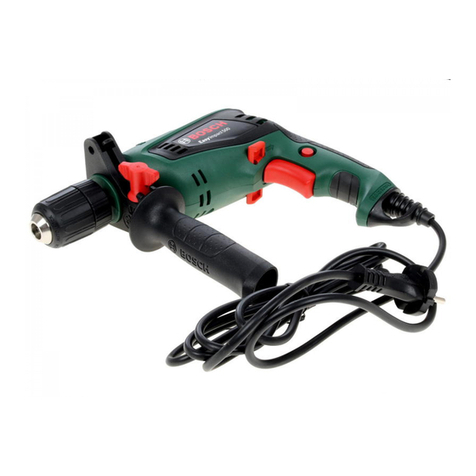
Bosch
Bosch PSB Easy Original instructions
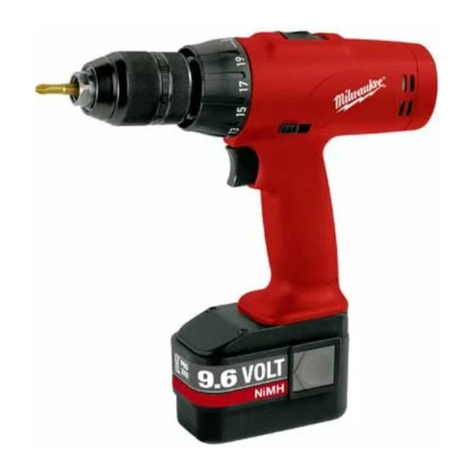
Milwaukee
Milwaukee PES 7.2 T Instructions for use

Black & Decker
Black & Decker KR50CRE Original instructions
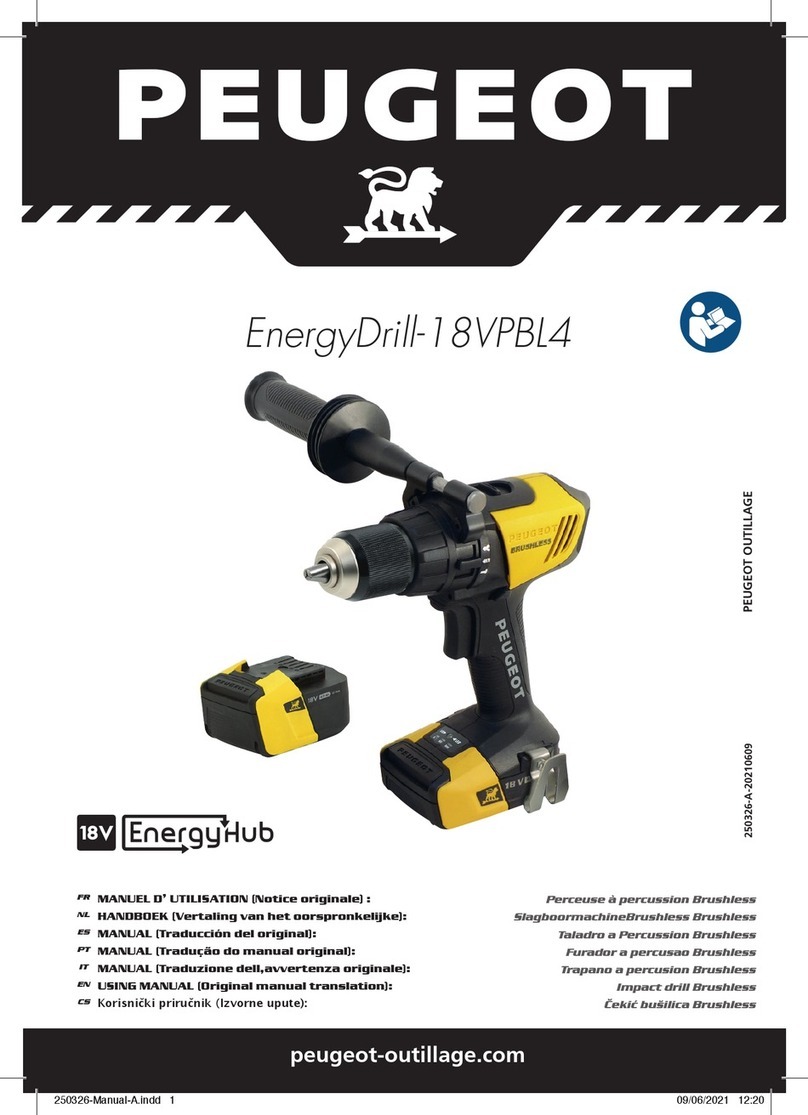
PEUGEOT
PEUGEOT EnergyDrill-18VPBL4 user manual
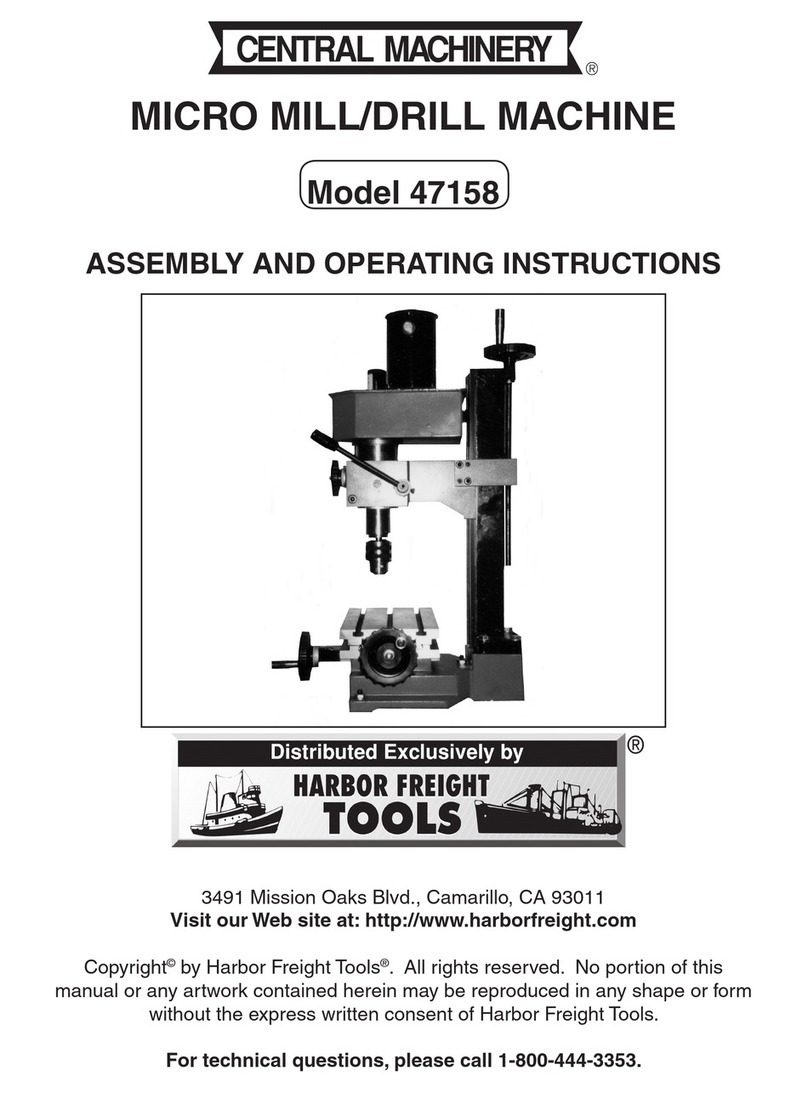
Central Machinery
Central Machinery 47158 Assembly and operating instructions

